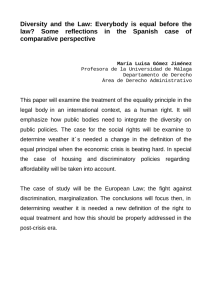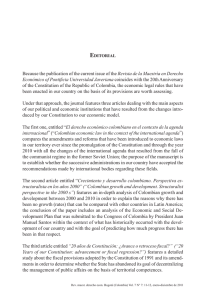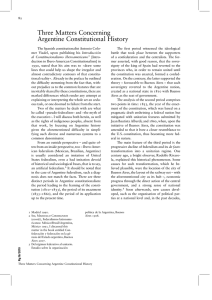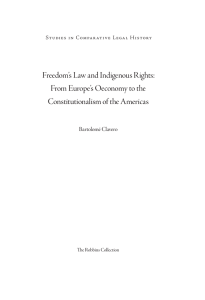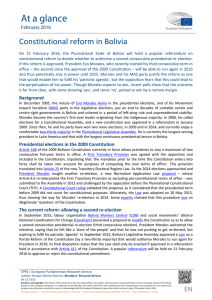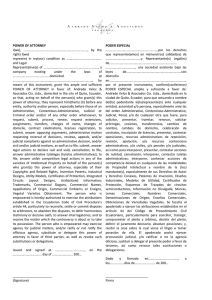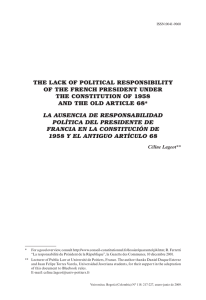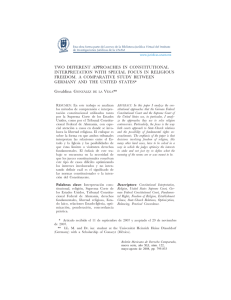English - SciELO Colombia
Anuncio
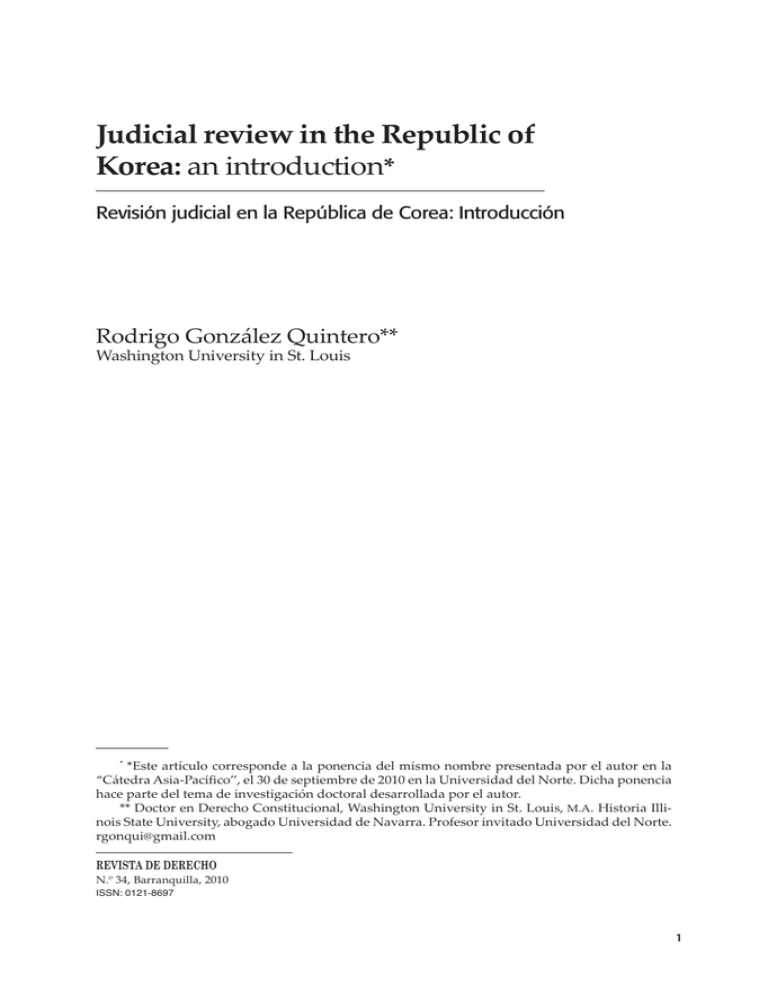
Judicial review in the Republic of Korea: an introduction* Revisión judicial en la República de Corea: Introducción Rodrigo González Quintero** Washington University in St. Louis * *Este artículo corresponde a la ponencia del mismo nombre presentada por el autor en la “Cátedra Asia-Pacífico”, el 30 de septiembre de 2010 en la Universidad del Norte. Dicha ponencia hace parte del tema de investigación doctoral desarrollada por el autor. ** Doctor en Derecho Constitucional, Washington University in St. Louis, M.A. Historia Illinois State University, abogado Universidad de Navarra. Profesor invitado Universidad del Norte. [email protected] REVISTA DE DERECHO N.º 34, Barranquilla, 2010 ISSN: 0121-8697 1 Abstract In the Republic of Korea, after almost forty years of constitutional provisions concerning judicial review, the 1987 Constitution created an effective system of judicial review powers vested on the Constitutional Court. Besides the assessment of the legislation’s constitutionality, the Court has power to decide upon the dissolution of political parties, impeachment cases, conflicts of competence, and constitutional complaints. These powers have given the Court a special status within the South Korean democratic system, enabling it to expand the meaning of the Constitution, and extending its protection over the citizens’ daily life. Key words: Republic of Korea, judicial review, democracy, Constitutional Court, comparative law. Resumen En la República de Corea, tras casi cuarenta años de disposiciones de rango constitucional en las que se consagraba el control constitucional, la Constitución de 1987 estableció un sistema efectivo de poderes de control constitucional otorgados a la Corte Constitucional. Además de revisar la constitucionalidad de las leyes, la Corte tiene la autoridad para decidir sobre la disolución de partidos políticos, la destitución de altos funcionarios, conflictos de competencia, y recursos de protección de derechos individuales. Los poderes antes enunciados han dado a la Corte una posición especial dentro del sistema democrático de Corea del Sur, habilitándola para ampliar el significado de la Constitución y extender su protección respecto de la cotidianidad de los ciudadanos. Palabras clave: República de Corea, control constitucional, democracia, Corte Constitucional, derecho comparado. Fecha de recepción: 8 de septiembre de 2010 Fecha de aceptación: 8 de octubre de 2010 2 revista de derecho, universidad del norte, 34: 1-17, 2010 JUDICIAL REVIEW IN THE REPUBLIC OF KOREA: AN INTRODUCTION 1. INTRODUCCIÓN The current system of judicial review in South Korea was established by the 1987 Constitution. Said Constitution was adopted within a democratization process, occurred between 1985 and 1987. After many months of street protests organized by the opposition, where millions of citizens participated, the regime led by President Chun Doo Hwan yielded and finally allowed the discussion of constitutional amendments. This process of constitutional reformation, intended mainly for the popular-direct election of the President, provided also for the re-establishment of an independent and effective system of judicial review headed by the Constitutional Court. After two decades of functioning, the Constitutional Court has rendered many thousands of decisions, erecting itself as one of the columns of the South Korean democratic regime. The jurisprudence of the Court has touched many elements of citizen’s daily life, usually expounding the meaning of the Constitution, protecting individual liberties, and performing the role of the real arbiter between the other branches of public power. The present article shows Korea’s long standing experience with judicial review prior to 1987 which, although ineffective most of the times, reveals some kind of preoccupation in regards of the necessity of such an institution. Then, the article follows the constitutional and legal framework determining the juridical and political status of the Court within the Korean system. It explains the organization and operation of the Court, its powers related not only to judicial review of legislation, but also to impeachment, dissolution of political parties, conflicts of jurisdiction, and constitutional complaints. This piece represents an introduction to Korean constitutional law. Given the current growing interest in the potential of affairs between Colombia and South Korea, I would like to contribute to the latter, in rendering a quick overview in one of the pillars of South Korean democracy: the Constitutional Court. revista de derecho, universidad del norte, 34: 1-17, 2010 3 Rodrigo González Quintero 2. JUDICIAL REVIEW IN SOUTH KOREAN HISTORY All of the South Korean constitutions, six in total since 1948, included provisions for some kind of judicial review (Ginsburg, 2002, p. 779). Yet, it was perceived as weak and useless given – up to 1987 – the South Korean strong presidential form of government (Kim, 2006, p. 30). Under the Constitution of the First Republic (1948 – 1960) the function of judicial review was assigned to the Constitutional Committee, composed by the Nation’s vice-president, five congressmen, and five Supreme Court’s justices. Although the Committee only was able to revise seven cases, it is regarded as a body subject to a compromise among the three branches of power, impossible to be framed either as political or judicial (Yoon, 1989, pp. 135-137). Reasons related to politicization of the judiciary and growing demands toward the protection of civil liberties, pressed for the creation of a Constitutional Court within the articles of the Second Republic’s Constitution, effective from 1960 to 1962 (Yoon, 1989, pp. 138-139). Among its powers were the revision of statutes, the final interpretation of the constitution, decision over eventual disputes arising between governmental offices, the dissolution of parties, controversies about presidential elections, and impeachment cases (Kim, 2006, p. 36). Ought to a coup d’ etat in May 1961, “the Court had no opportunity to function at all.” (Yoon, 1989, p. 140) The Constitution of the Third Republic (1962 – 1972) provided for judicial review, with powers granted to the Supreme Court. There, the Court “had the final authority to review the constitutionality of statutes as well as other governmental acts.” (Yoon, 1989, p. 141) Under the Constitution of the Fourth Republic (1972 – 1980), judicial review functions were vested on the Constitutional Committee, although this revived body “was closer in actuality to the Constitutional Court of the 1960 Constitution than the Constitution Committee of the 1948 Constitution.” (Yoon, 1989, p. 146) The Committee was maintained during the Constitution of the Fifth Republic (1980 -1987). As it occurred during the Fourth Republic, the Committee never assessed 4 revista de derecho, universidad del norte, 34: 1-17, 2010 JUDICIAL REVIEW IN THE REPUBLIC OF KOREA: AN INTRODUCTION the constitutionality of a statute. In other words, “one would not be far from the truth should he suppose that the role of the Constitution Committee was devised to be feeble and insignificant.” (Yoon, 1989, p. 150) (Yoon, The Constitutional Court System of Korea: The New Road for Constitutional Adjudication, 2001) 3. CONSTITUTIONAL AND LEGAL FRAMEWORK OF JUDICIAL REVIEW IN SOUTH KOREA 3.1. The Status and Organization of the Constitutional Court within the 1987 Constitution The Constitutional Court is established on three articles – 111, 112 and 113 – which compose a totally separate chapter – Chapter VI – within the Korean Constitution, differentiating it from the three traditional branches of power. This is worthy of note since the Constitution only contains ten chapters. The twenty six articles of Chapter III provide for the organization of the legislative power, vested in the National Assembly. Quite more extensive is Chapter IV, which through thirty five articles organizes the executive power, led by the President as both Head of the State and the Executive Branch. Chapter V establishes the judicial power, between articles 101 and 110. Therefore, and despite the few constitutional articles reserved to it, the Constitutional Court is elevated by the Constitution, since it is conceived as a separate power from the three traditional branches. The Court’s status is, at least in the constitutional text, equal to those ones performing the executive, legislative, and judicial functions respectively. Article 1111 is divided in five sections. Section 1 establishes the subject-matter jurisdiction of the Constitutional Court, as follows: (1) The constitutionality of a law upon the request of the courts; (2) Impeachment; (3) Dissolution of a political party; (4) Competence disputes between State agencies and local governments, and between local governments; (5) Constitutional complaint as prescribed by Act. 1 I am using the official English translation of the Korean Constitution, provided by the Court at the book The First Ten Years of the Korean Constitutional Court, 1988-1998. revista de derecho, universidad del norte, 34: 1-17, 2010 5 Rodrigo González Quintero Sections 2 and 3 institute the composition of the Court, as well as the appointment process and the requirements for its members. Thus, the Court “shall be composed of nine Justices qualified to be court judges, and they shall be appointed by the President.” Section 3 specifies that among the Justices referred in section 2, “three shall be appointed from persons selected by the National Assembly, and three appointed from persons nominated by the Chief Justice of the Supreme Court. Section 4 says that the president of the Court “shall be appointed by the President from among the Justices with the consent of the National Assembly.” Article 112 is composed by three sections. Section 1 sets the office term for the Justices, that “shall be six years and they may be reappointed under the conditions as prescribed by Act.” Section 2 prohibits any political affiliation for the Justices, stating that they “shall not join any political party, nor shall they participate in political activities.” Finally, Section 3 establishes the events for removal from office, affirming that no Justice “shall be expelled from office except by impeachment or a sentence of imprisonment without prison labor or heavier punishment.” The three sections of article 113 are residual clauses. Section 1 establishes the necessary quorum for valid decisions as follows: “When the Constitutional Court makes a decision of the unconstitutionality of a law, a decision of impeachment, a decision of dissolution of a political party or an affirmative decision regarding the constitutional complaint, the concurrence of six Justices of more shall be required.” On the other hand, Section 2 states that the Court “may establish regulations relating to its proceedings and internal discipline and regulations on administrative matters within the limits of Act.” And finally, Section 3 provides that “the organization, function and other necessary matters of the Constitutional Court shall be determined by Act.” The constitutional provisions concerning the Court are broad, and – as it is stated and foreseen on the Constitution itself – were subject to legislative development. As a result, all the regulations regarding the establishment, organization, and functions of the Korean Constitutional 6 revista de derecho, universidad del norte, 34: 1-17, 2010 JUDICIAL REVIEW IN THE REPUBLIC OF KOREA: AN INTRODUCTION Court are contained in detail at the Constitutional Court Act, which entered into force on September 1st 1988. This statute is composed of five chapters – General Provisions, Organization, General Procedure of Adjudication, Special Adjudication Procedures, and Penal Provisions – and seventy six articles. 3.2. Justices of the Constitutional Court: Legal Framework Under the General Provisions chapter, the Act restates the subjectmatter jurisdiction of the Constitutional Court (art. 2), the number and term of Justices (art. 3 and art. 7 respectively) and the mechanism to be followed for their appointment (art. 6), the process for office removal affecting the Justices (art. 8), and the prohibition for them upon participating in politics (art. 9). Regarding the number of Justices, at first – and without any basis stated on the constitutional articles – the Act established two classes of Justices: six of them were “standing Justices” and the remaining three were “non-standing” ones. In fact, the former served full-time earning salary, while the latter had only honorary status with no salary at all. Apparently, the only reason for such a distinction comes from a prediction of low case load to be resolved by the Court, enforced by the timid – almost null – performance of prior organs with judicial review powers. The Constitutional Court Act was finally amended in November 1991, and all nine Justices have the same standing status (Yoon, 2001, p. 8). This first chapter of the Act also stresses the independence of the Justices (art. 4), stating that they “shall adjudicate independently according to the Constitution and laws, guided by their consciences.” This provision is almost identical to article 103 of the Constitution, which commands all members of the judicial branch to perform alike since “judges shall rule independently according to their conscience and in conformity with the Constitution and Act.” The short reference within the Constitution in regards of the qualifications of Justices (art. 5 Sec. 2), is broaden by the Act in article 5. There, a minimum age of forty years is set, as well as the prior professional experience required. Thus, the Act restricts the possibilities revista de derecho, universidad del norte, 34: 1-17, 2010 7 Rodrigo González Quintero to people “who have held the following positions for fifteen or more years:” Judge, public prosecutor or attorney; Attorney engaged in legal affairs at state agencies, state-owned or public enterprise, government invested institution or other corporation; Attorney who has held a position equal or higher than assistant professor of law in an accredited college. In sum, the combined provisions of the Act and the Constitution, establish that in order to be a Justice the candidate should be a forty years old – or older – licensed attorney, qualified to be a court judge, with at least fifteen years experience either on legal affairs on the public sphere, or the same amount of time as a law professor. One should note that the qualifications required for being a Constitutional Court Justice are exactly the same as those ones established to be a court judge belonging to the judicial power (art. 42 Court Organization Act). In fact, the terms of appointment and salaries are identical for Justices of both the Constitutional and the Supreme Courts. Many commentators, however, emphasize the necessity of a reformation upon the qualifications in order to be a Justice of the Constitutional Court. To obtain the qualification as a judge, Justices must have passed the state judicial examination, besides the attendance of the Judicial Research and Training Institute for two years. The reserves over said requirements are directed to the fact that they are understood as a practical exclusion toward law professors to be seated at the bench. Korean law professors, after graduating from law schools usually have gained their academic credentials abroad, pursuing their careers out of the judicial bureaucracy, as opposed to those belonging to the judiciary and the legal profession, whom have passed the extraordinary judicial exam and have been trained within the hierarchy of the Judicial Institute. Perhaps that explains why by 1993, only four law professors had passed the judicial exam and then were qualified as a lawyer (Healy, 2001, pp. 226-227) (Yang, 1993, pp. 304-306) (Kim J. , 2001, p. 25). Anyway, the first Court was composed by eight former judges, one former Justice of the Supreme Court, and one senior public prosecutor. The second Court also included eight former judges and one former prosecutor (Healy, 2001, p. 226). 8 revista de derecho, universidad del norte, 34: 1-17, 2010 JUDICIAL REVIEW IN THE REPUBLIC OF KOREA: AN INTRODUCTION 3.3. Operation of the Constitutional Court In general, cases before the Court are decided en banc; art. 22 of the Act states that “except as provided in this Act, the adjudication of the Constitutional Court shall be assigned to the Full Bench composed of all the Justices.” The exception noticed refers to art. 72, which contemplates, up to the Court President’s discretion, prior review of constitutional petitions by a panel composed by three Justices. As it will be explained later, the final decision of such a petition is made, however, by the Full Bench. The Act provides also for both deliberating and deciding quorums. The review and discussion of a case before the Court requires, at least, the presence of seven Justices (art. 22, Sec. 1). Decisions, according to Sec. 2 of the same article, are made “on a case by the majority vote of Justices participating in the final discussion.” Nonetheless, the same section establishes a especial majority of six votes on the following events: upholding decisions on the constitutionality of statutes, impeachment, constitutional petition or dissolution of political party, and also overruling precedents on interpretation and application of the Constitution or laws made by the Court. The Act requires the assistance of a lawyer during the proceedings, regardless the private or public nature of the party (art. 25). Nevertheless, article 70 states that “if a person who desires to file a constitutional complaint has no financial resources to appoint an attorney as his counsel, he may request the Constitutional Court to appoint a courtappointed counsel.” Although the proceedings before the Court begin with a written request for adjudication (art. 26), however according to article 30, the method of review varies: proceedings in regards of impeachment, dissolution of parties, or competence dispute “shall be conducted through oral arguments,” while the ones on constitutionality of statutes or constitutional complaint shall be conducted without oral arguments.” At any event, the time limit for a decision to be rendered by the Court is six months, as article 38 of the Act commands. revista de derecho, universidad del norte, 34: 1-17, 2010 9 Rodrigo González Quintero 4. THE SUBJECT-MATTER JURISDICTION OF THE CONSTITUTIONAL COURT As it is prescribed by the Constitution, and then developed by the Constitutional Court Act, the subject-matter jurisdiction of the Court encompasses five specific issues: judicial review of legislation enacted by the National Assembly, impeachment, dissolution of political parties, competence disputes between diverse governmental agencies, and constitutional complaint. The jurisdiction of the South Korean Court represents many similarities with other institutions present in comparative law. The one closer to Korean citizens, the constitutional complaint, is also present in Germany, Spain, and Colombia. From the German system derives also the figure of impeachment, dissolution of political parties, and conflicts of competence. 4.1. Adjudication on Constitutionality of Statutes The power to decide upon the constitutionality of legislation enacted by the National Assembly is the jurisdiction’s core of the Constitutional Court (James West & Dae-Kyu Yoon, 1992, p. 88). Although generally regarded as a centralized – or concentrated – model of judicial review of legislation, the Constitutional Court lacks power to review the constitutionality of administrative decrees, regulations or actions. Said function, according to article 107 of the Constitution, belongs to the realm of the Supreme Court. It is also noteworthy the restricted nature of the figure, since it can only be triggered by the discretion of a lower court, and then referred officially to the Constitutional Court by the Supreme Court. The main points of this attribution are stated in articles 41, 44, 45, and 47 of the Act. Basically, when the constitutionality of a statute relevant for a case is doubtful, a court “shall request to the Constitutional Court, ex officio or by decision upon a motion by the party, an adjudication 10 revista de derecho, universidad del norte, 34: 1-17, 2010 JUDICIAL REVIEW IN THE REPUBLIC OF KOREA: AN INTRODUCTION on the constitutionality”2 of said statute, and “shall do so through the Supreme Court.”3 Furthermore, “the parties to the original case and the Minister of Justice may submit to the Constitutional Court and amicus brief on the issue of whether or not statutes are constitutional.”4 The Act also permits to decide upon the constitutionality of the whole statute or any of its provisions.5 A decision rendered by the Constitutional Court of holding the statute’s unconstitutionality has erga omnes effects, since it “shall bind the ordinary courts, other state agencies and local governments.”6 One should note that this power granted to the Constitutional Court could remain passive, marginal, or useless, unless courts would be willing to refer controversies to it. Besides, ought to the civil legal tradition dominant in South Korea, perhaps courts would be reluctant to hesitate upon the constitutionality of enacted legislation.7 Hence, does this mean that the Korean citizen is left without relief when a regular court asserts the constitutionality of a statute, even when the party believes the opposite? The answer is no, since “if the motion made under article 41(1) for adjudication on constitutionality of statutes is rejected, the party may file a constitutional complaint with the Constitutional Court.”8 At any case, this is not a path that entails review of the lower court’s decision denying the referral, but rather is a new case before the Constitutional Court entailing whether the statute is constitutional (James West & Dae-Kyu Yoon, 1992, p. 89). The Constitutional Court have adopted, in practice, the German custom of delivering decisions concerning the constitutionality of legislation 2 CCA, Art, 41(1). 3 CCA, Art, 41(5). 4 CCA, Art, 44. 5 CCA, Art. 45. 6 CCA, Art, 47(1). 7 Many scholars have compared the role of judges in common law systems and civil law systems. In the latter, traditionally judges have been regarded as mere applicants of statutory law, as it was stated by Montesquieu, due probably to the revolutionary ideas transmitted by the French. Thus, in the past civil law judges were not conceived to create law. See john Merryman, The Civil Law Tradition (2007); Pablo Pérez Tremps, Tribunal Constitucional y poder judicial (1985). 8 CCA, Art, 68(2). revista de derecho, universidad del norte, 34: 1-17, 2010 11 Rodrigo González Quintero on different categories, apparently to avoid exhausting confrontations with other branches of government (James West & Dae-Kyu Yoon, 1992, p. 99). In fact, this practice permits a kind of dialogue between state organs, operating as a guide to agencies concerning the application of statutory law, and persuading some public officials to reconsider decisions enlightened by constitutional interpretation (Ginsburg, 2002, p. 780). Thus, using a technique of effects’ gradation and in addition to hold the statute’s unconstitutionality, the Court could pronounce a statute “non-conforming” with the Constitution, “unconstitutional limitedly,” or “conformable limitedly” (Ginsburg, 2002, p. 780). Under the first category – non-conforming – the statute is not invalidated, although it does present a serious constitutional defect; hence, the Court may require from the National Assemble the pertinent modifications, probably establishing a deadline in the near future for them to be made. Otherwise, the norm would be invalidated (Ginsburg, 2002, p. 780) (James West & Dae-Kyu Yoon, 1992, p. 100). In the second category – unconstitutional limitedly – the Court would find a statute coherent with the Constitution, although noting that it is being applied in an unconstitutional way. The final category – conformable limitedly – allows the Court to declare the constitutionality of a statute, as long as it is interpreted in a proper way (Ginsburg, 2002, p. 780). 4.2. Impeachment The institution of impeachment presents at least two defined steps: one within the legislature and the other before the Constitutional Court. As prescribed both the Constitution and the Act,9it is under the province of the National Assembly to pass a motion – resolution – to impeach a wide range of high state officials, when any of them violates the Constitution or the laws in the course of their public service. Subject to impeachment are the President, Cabinet members, State Council members, Justices of the Constitutional Court and the Supreme Court; judges, the Chairman and Commissioners of the Board of Audit and 9 S. KOREA CONST. Art. 65.; CCA. Art. 48. 12 revista de derecho, universidad del norte, 34: 1-17, 2010 JUDICIAL REVIEW IN THE REPUBLIC OF KOREA: AN INTRODUCTION Inspection, Commissioners of the National Election Commission, and other public officials are also subject to impeachment. The process before the Court begins when the prosecutor – the Chairman of the Legislation and Justice Committee of the National Assembly – presents a copy of the motion of impeachment and requests adjudication from the Constitutional Court.10 Once the motion is adopted, the official is automatically suspended from his/her post.11 If the Court decides to sustain the motion for impeachment, it “shall pronounce a decision that the accused person be removed from the public office.”12 The upholding of an impeachment does not exempt the official from civil or criminal liabilities, and prevent him or her from performing posts as public official for the following five years.13 4.3. Dissolution of Political Parties According to article 55 of the Act, the executive -upon deliberation of the State Council- may request from the Constitutional Court a declaration stating the dissolution of a political party. Said provision applies to any political party presenting objectives or activities opposed to the basic democratic order. Even, during the pertinent proceedings, the Court is empowered to suspend the activities of this party until the final decision is reached.14 If the Court rules for the dissolution, then the decision should be executed by the National Election Commission.15 It should be said that this attribution of the Court concurs, or at least overlaps, those granted to judicial and executive organs to outlaw anti-state organizations, under the National Security Act (James West & Dae-Kyu Yoon, 1992, pp. 87-88). Unless the situation involves a registered political party, the process would be out of the Court’s realm. 10 CCA. Art 49. 11 CCA, Art. 50. 12 CCA. Art. 53. 13 CCA, Art. 54. 14 CCA, Art. 57. 15 CCA, Arts. 59 and 60. revista de derecho, universidad del norte, 34: 1-17, 2010 13 Rodrigo González Quintero Hence, this means otherwise, that the Constitutional Court has not an ample power to perform the role as the basic guardian of the Korean democratic system (James West & Dae-Kyu Yoon, 1992, pp. 87-88). 4.4. Competence Dispute According to the Act, competence conflicts are resolved by the Court. The Act provides for disputes arising among state agencies at the national level, state agencies and local governments, or between local governments.16 Article 62 explains that state agencies are the Executive, the National Assembly, the National Election Commission, and the ordinary courts. Thus, the Court is called to solve conflicts arising between branches of power, but never to solve existing disputes within each branch itself. The conflict involves actions or omissions, and the complaint should be brought to the Court within two months after it is known, and no later than six months after it occurs.17 As a provisional remedy, it is under discretion of the Court to suspend any effect of the actionomission referred until a final decision is rendered. If the Court finds an infringement of competence, thus the holding would be for revoking the action-omission, or confirmed it to be void. Of course, any holding from the Constitutional Court in regards of a competence dispute binds all state agencies and local governments.18 At least one matter should be noted here. Competence conflicts are more likely to arise on federal systems, and between the branches of power equivalent at the national and state levels. South Korea is a centralized country, and the attributions of each of the branches are provided by the Constitution. No shared sovereignty exists; neither there is a high degree of local autonomy – as in any other centralized state – , thus such conflicts are unlikely to appear (James West & Dae-Kyu Yoon, 1992). 16 CCA, Art. 61. 17 CCA, Arts. 61(2) and 63. 18 CCA, Arts. 63, 65, 66, 67. 14 revista de derecho, universidad del norte, 34: 1-17, 2010 JUDICIAL REVIEW IN THE REPUBLIC OF KOREA: AN INTRODUCTION 4.5. Constitutional Complaint As a development of the constitutional text, the Act provides for a direct access to the Constitutional Court, under the figure of a constitutional complaint. Therefore, any person may file a constitutional petition before the Court, when any of his/her constitutional protected rights has been violated by an action or omission – exercise or non-exercise – from the public power. The act is explicit stating that judgments of courts are not subject to the figure of constitutional complaint. The main nature of the institution is subsidiary, since it only operates when all of the other legal or judicial remedies are exhausted.19 The Act, as asserted before, differentiates between two kinds of petitions. The one of article 68 Sec. 1, conceived as protection for basic rights, and those one of Section 2 in the same article, prescribed for events in which the motion ex parte challenging the constitutionality of a statute is denied. For practical reasons I will address each of them separately. The petition based on violation of rights refers to those ones guaranteed by the Constitution. Although the latter contains an ample enumeration of rights – chapter II – , it is not to be understood as numerus clausus. On the contrary, well after many rights are signaled, article 37 asserts that “freedoms and rights of citizens shall not be neglected on the grounds that they are not enumerated in the Constitution.” Thus, there may be the case in which a citizen invokes protection before the Court, for a right not mentioned within the constitutional text. At any event, the petition should be filed within the following time periods: two months after the transgression is known, six months after the transgression has occurred, and one month after the decision of previous relief processes has been final.20 19 CCA, Art. 68(1). 20 CCA, Art. 69(1). revista de derecho, universidad del norte, 34: 1-17, 2010 15 Rodrigo González Quintero As it was said before, for cases related to constitutional complaints, the Court may operate through Panels – composed by three Justices – for performing a prior review of the petition. The Panel has the power to dismiss the complaint, but it should be by unanimity; otherwise, the case is transferred to the Court en banc for decision.21 The Act also permits the submission of amicus briefs by any state agency or public organization interested on the case. The effects deriving from a decision upholding the constitutional complaint are noteworthy, since, via complaint, the Court may invalidate the law or legal provisions causing the right’s transgression. Indeed, the decision could entail either revocation of governmental power that violates basic rights; or on the other hand, confirmation that the non-exercise of governmental power is unconstitutional, event in which the respondent must take new action according to the decision. Anyway, if the Court considers that the defendant’s actionomission is due to unconstitutional laws or provisions, it may declare in the holding that the law or its provisions are unconstitutional.22 The decision of the Court binds all state and local organs. The complaint based on the motion’s denial for the unconstitutionality of a statute must be presented within fourteen days after said denial occurred. From there the procedure before the Court operates in the same way than the regular process of judicial review of legislation.23 5. EPILOGUE The Republic of Korea has have systems of judicial review continuously during the last five decades. Whether they were useless or effective, the Constitutional Committee, the Constitutional Court, and the Supreme Court, had constitutional powers to perform judicial review between 1948 and 1987. The constitutional amendments occurred in 1987, 21 CCA, Art. 72. 22 CCA, Art. 75. 23 CCA, Arts. 74(2) and 75(6). 16 revista de derecho, universidad del norte, 34: 1-17, 2010 JUDICIAL REVIEW IN THE REPUBLIC OF KOREA: AN INTRODUCTION after months of public unrest and popular mobilization, prescribed the creation of a Constitutional Court. The 1987 Korean Constitution grants many powers over the Court. Besides the assessment regarding the constitutionality of legislation enacted by the legislature, the Constitutional Court has authority to decide constitutional complaints, disputes arising from diverse competences exercised by public institutions, the dissolution of political parties, and impeachment. Although any analysis of the Court’s jurisprudence is out if the scope of the present article, it is pertinent, however, to highlight the performance of its functions and powers as a way to fortify the South Korean democratic process. And it has been possible due to the constitutional and legal framework which enabled it. A framework explored and explained in the previous paragraphs. BIBLIOGRAPHY Ginsburg, T. (2002). Confucian Constitutionalism? The Emergence of Constitutional Review in Korea and Taiwan. Law and Social Inquiry , 779. Healy, G. (2001). Judicial Activism in the New Constitutional Court of Korea. Columbia Journal of Asian Law , 226-227. James West & Dae-Kyu Yoon. (1992). The Constitutional Court of the Republic of Korea: Transforming the Jurisprudence of the Vortex? American Journal of Comparative Law , 88. Kim, C. J. (2006). Constitutional Review in Korea. Korean Journal of International and Comparative Law , 30. Kim, J. (2001). Some Problems with the Korean Constitutional Adjudication System. Journal of Korean Law , 25. Yang, C. S. (1993). The Judiciary in Contemporary Society: Korea. Case Western Reserve Journal of International Law , 304-306. Yoon, D.-K. (1989). Judicial Review in the Korean Political Context. Korean Journal of Comparative Law , 135-137. Yoon, D.-K. (2001). The Constitutional Court System of Korea: The New Road for Constitutional Adjudication. Journal of Korean Law , 8. revista de derecho, universidad del norte, 34: 1-17, 2010 17

